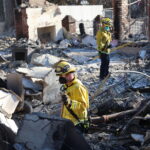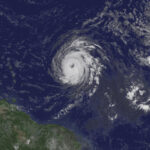An air-ambulance helicopter crash in Ohio last year that killed three crew members revealed sweeping safety lapses and rule violations, federal accident investigators concluded Tuesday.
The Survival Flight Inc. copter slammed into a wooded hillside in southeastern Ohio during snow squalls on Jan. 29, 2019, because of the company’s “inadequate management of safety,” the National Transportation Safety Board said at a meeting to conclude its probe.
Survival Flight didn’t produce required risk analyses before each flight, didn’t track whether other companies had rejected flying in deteriorating conditions and had a history of berating pilots who raised safety concerns, the NTSB concluded.
NTSB Chairman Robert Sumwalt used unusually terse language to describe an interaction with company management shortly before the meeting.
“It does bother me when people accuse us of having an agenda,” he said. He urged the company to listen to the board’s recommendations so that it could improve safety.
Investigators were unable to determine whether the pilot on the helicopter got disoriented after entering snow showers or simply descended too low as she was attempting to turn back. But the findings painted a grim picture of Survival Flight’s operations.
The air-ambulance helicopter was on the way to pick up a patient despite the fact that two other competitors had declined the job due to bad weather.
Senior officials at the company were accused of screaming at employees who raised safety concerns and former employees alleged they were fired for doing so. Employees reported they believed they were under pressure to fly in dangerous conditions. A review after the crash by U.S. regulators found the company violated multiple rules, according to the NTSB records.
The company believes the crew was well trained and performed all required preflight checks, said spokesman Ryan Stubenrauch.
“Nothing in the NTSB report says this was anything other than a tragic accident,” Stubenrauch said, referring to preliminary information released by investigators.
Addressing allegations that the managers pressured employees, he said: “We’ve always encouraged open communication and are confident that our employees discuss any issues or concerns with the appropriate staff.”
The pilot on the helicopter involved in the accident, Jennifer Topper, was just arriving to work before dawn when she accepted the flight, according to NTSB records. There was no evidence Topper checked the weather before taking off, according to NTSB records.
Other officials at the company had earlier agreed to fly to a hospital to pick up an emergency room patient. Another pilot who had worked overnight said he had monitored the weather, but call records showed he’d spend only 28 seconds doing so.
The helicopter, en-route to a hospital in Pomeroy, Ohio, crashed near the town of Zaleski.
Two other air-medical helicopter operations had refused the request because of low visibility, snow showers and a forecast for possible dangerous icing conditions, according to NTSB records.
Survival Flight wasn’t aware of the other companies’ decisions despite a requirement that it ask the hospital whether competitors had declined.
Shortly before the end of the 22-minute flight, data records showed that the pilot turned right, then made a sharp left turn accompanied by abrupt maneuvers that would have bucked the aircraft.
A cockpit recording captured Topper saying she wanted to change heading several minutes before impact, but the recording was of such poor quality most of her words couldn’t be deciphered.
The helicopter struck a wooded hillside and broke into pieces.
The crash killed medical personnel Bradley Haynes, 48, Rachel Cunningham, 33, and Topper, 34.
The helicopter twice flew through snow squalls shortly before the crash, an NTSB analysis found. While it’s possible to fly legally in light snow, the company wasn’t authorized to operate when its pilots couldn’t see the ground or when heavy snow posed a risk of freezing to the copter.
The lack of adequate oversight by the Federal Aviation Administration contributed to the cause of the crash, NTSB found. The FAA’s inspector for Survival Flight wasn’t experienced in helicopter operations and had signed off on procedures that weren’t legal, NTSB said.
A review of Survival Flight’s operations by the FAA after the crash found the company’s riskanalyses, required before each flight, weren’t being done properly. The NTSB documented previous flights in poor weather that were apparently in violation of FAA regulations.
If a pilot declined to fly, the chief pilot “would call within about 10 minutes and would cuss out our pilots and belittle them,” the NTSB quoted one as saying. “He would yell so loud on the phone that you could hear it, just standing within earshot.”
Survival Flight is based in Arkansas and has bases there and in Illinois, Missouri, Ohio and Oklahoma, according to its website.
Was this article valuable?
Here are more articles you may enjoy.

 Tesla Showroom Strikes, Vandalism Sparked by Fury Against Musk
Tesla Showroom Strikes, Vandalism Sparked by Fury Against Musk  Scammers Are Pushing Auto Loan Fraud to Record Levels
Scammers Are Pushing Auto Loan Fraud to Record Levels  After the Flames: Preparing for the Growing Fraud Threat in Los Angeles
After the Flames: Preparing for the Growing Fraud Threat in Los Angeles  An Unusually Active Hurricane Season Is in Store for the Atlantic
An Unusually Active Hurricane Season Is in Store for the Atlantic 